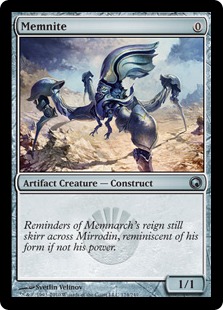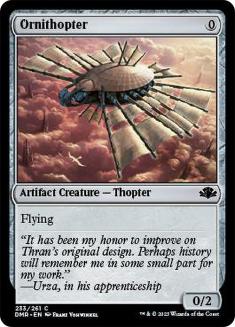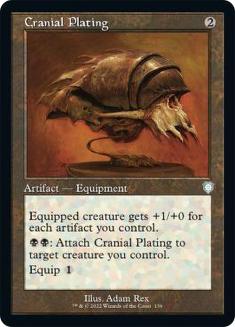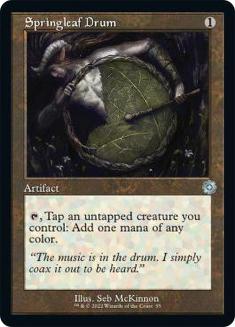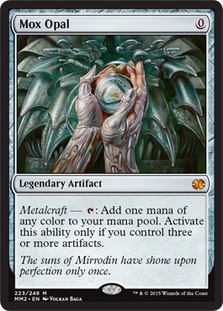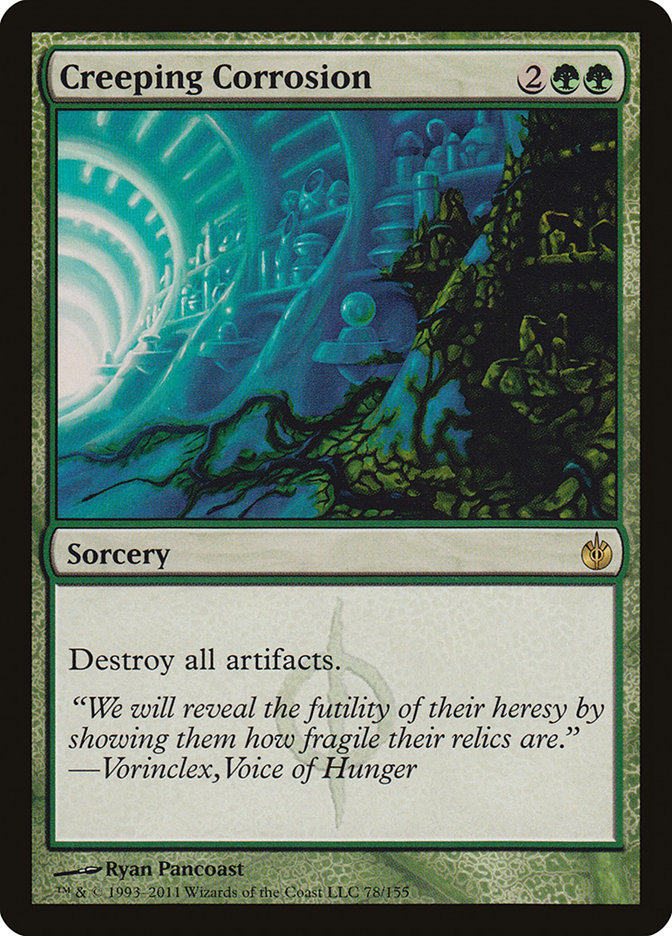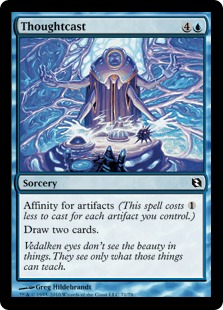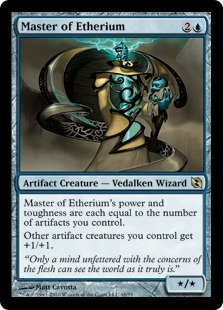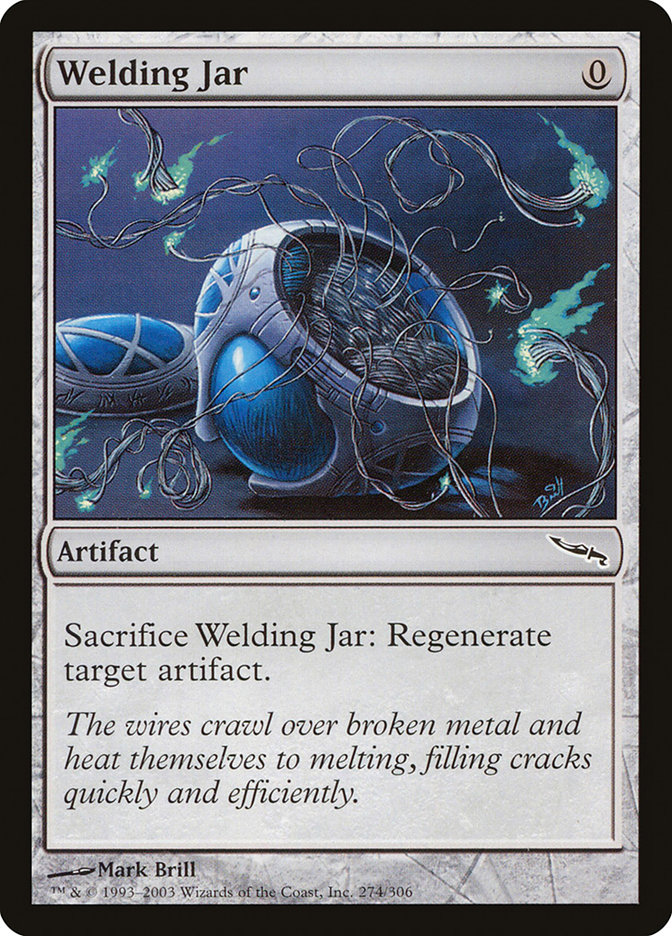Looks like it’s time for another PTQ season, and this time the format is set to Modern.
Last weekend, I took a trip down to Philadelphia to battle in the very first Modern PTQ for Pro Tour Honolulu. Although I didn’t walk away with the
proverbial “Blue Envelope”, I did learn a thing or two. First things first, let’s take a look at the 75 I played:
Creatures (26)
- 4 Arcbound Ravager
- 4 Ornithopter
- 2 Master of Etherium
- 4 Steel Overseer
- 4 Memnite
- 4 Signal Pest
- 4 Vault Skirge
Lands (16)
Spells (18)
Sideboard

Here we have a fairly stock Affinity list similar to the one I played at Grand Prix Richmond a while back. Without a big Modern tournament to prepare for,
I never really had the chance to update the list after the GP and went into the PTQ underprepared because of it. Now that there are PTQs to worry about,
not to mention another Modern Grand Prix in a little over a month, I’m ready to make some improvements.
Before I get into updating the deck however, there are two interesting scenarios from the PTQ itself I’d like to take a look at.
This particular hand came to me on the play game 3 of round 1 versus Chris Mascioli. Mascioli was playing LSV’s new Angel Pod list- a Birthing Pod variant
that eschews the Melira combo in exchange for the Archangel of Thune/Spike Feeder combo and more open deck slots for disruption.
This hand is very interesting for a couple of reasons. First off, I know a lot of people would be turned off by having three copies of Mox Opal in their
opening hand. And while I agree it isn’t ideal, it really isn’t as bad as it seems. The first one is still going to be excellent, while the other two will
merely act as Lotus Petals. The first “Lotus Petal” can help fuel an explosive start and you can hold the second one in your hand to play a three drop down
the line.
As for the rest of the hand, being able to put a Cranial Plating and an evasive threat on the board turn 1 is very strong and would automatically warrant a
snap keep in any game 1 situation. Unfortunately, game 3 versus any B/W/G deck, you’re going to be facing down everything from Harmonic Sliver/Qasali
Pridemage to any number of Abrupt Decays that will make going all-in on Cranial Plating look rather embarrassing.
Even still, I ultimately decided to keep the hand. Even if Chris has the removal spell for Cranial Plating, you’re still going to get at least one hit in,
and if he doesn’t have it, you probably just win the game. It’s totally reasonable for the Pod player to keep a hand capable of playing a turn 2 Birthing
Pod that just doesn’t have the removal spell. Additionally, with this hand you can easily just draw another Plating or a Master of Etherium/Etched Champion
to grind out the game with.
Not to mention, if you’re not willing to go all-in, you probably shouldn’t be playing a deck like Affinity.
As it turns out, the game followed that exact script with one slight nuance. Although Mascioli didn’t have a turn one accelerant, he had the Abrupt Decay
for Plating so I was only able to get one big hit in. I did however draw an Etched Champion and it looked like I was going to have a decent chance to grind
out a victory. Well….until he played this card:
After the Creeping Corrosion hit, I was left with not a single permanent in play. Although this hand in particular had no chance of beating the four mana
sorcery, not many six card hands would have either. The real mistake I made here was not sideboarding in Thoughtseize. I had forgotten that the Angel Pod
lists were running Creeping Corrosion and was expecting the usual Kataki, War’s Wage.
The second scenario came round three against my Kikki-Pod opponent. Late into game one, we found ourselves in an interesting board position:
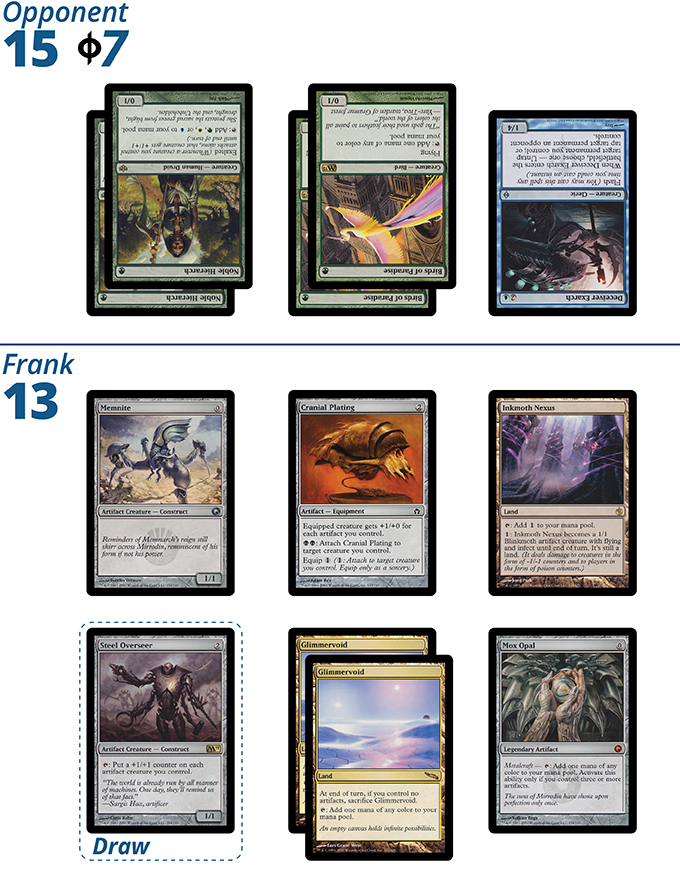
We both have no cards in hand and I’m going to draw Steel Overseer.
This may look like an easy turn, but this play was actually incredibly complex. The simplest thing I could have done would have been to animate Inkmoth
Nexus, equip Cranial Plating, and attack. This way my opponent has to chump with a Birds and I get to play Steel Overseer in my second main phase.
However, there is one cardinal rule to never, ever forget when playing Affinity: people almost always forget about the instant equip on Cranial Plating. It
comes up so infrequently that anyone who doesn’t have a lot of experience playing the deck usually doesn’t even realize it is an option. Taking that
information into account, that changes the play quite a bit.
Now, say we animate the Inkmoth Nexus and decline to equip, leaving up Glimmervoid and Mox Opal for the instant equip. Following this line you would now
think it correct to also attack with Memnite. Assuming the opponent does block the Inkmoth Nexus with Birds, he will either have to let Memnite through,
chump with a Noble Hierarch, or trade with Deceiver Exarch (thanks to instant-equip), taking away Kiki-Jiki, Mirror Breaker as a draw to automatically win
the game.
Although it would technically be the right call to attack with Memnite in this spot, it just doesn’t practically go along with the belief that
people always forget about the instant equip of Cranial Plating. The Memnite attack, although correct, will also serve to raise a red flag to the opponent.
“Why is he attacking his 1/1 into my 1/4? Oh right, he can instant equip Cranial Plating. Better block that Inkmoth.”
All things considered, I decided to go for the best bluff possible and attack with just the unequipped Nexus. Although it was clear my opponent was
suspicious why I hadn’t equipped, it wasn’t enough to outweigh his excitement of getting another turn before he had to start chumping with Birds of
Paradise. One instant equip later and I had won the game without giving my opponent another draw step.
Missing the attack with Memnite is a medium risk well worth the reward of winning the game on the spot with Inkmoth Nexus. Being able to identify spots
where you can make a play like this can spell the difference between winning or losing a tournament.
Although I ended up winning the match, my tournament fell short when I lost to a U/W/R Splinter Twin deck the following round. As I said earlier, after
getting a second tournament in with this deck, I’m ready to make some changes.
Before Grand Prix Richmond, I had never played Modern Affinity with the inclusion of Thoughtcast. Thinking back to the days of Affinity in Standard though,
the idea seemed awesome. A one mana Divination? Count me in! However, after getting a bunch of matches in with the card I’ve found out that often just
isn’t the case. Without having access to more actual artifact lands, Thoughtcast ends up costing two or three mana more frequently than you would like.
Even though that might seem workable, Affinity is a deck that needs to use its mana as efficiently as possible, and paying more than one mana to draw a
couple of cards simply doesn’t fit the bill.
Affinity’s best games are when it can have the most explosive turn 1 possible. Although Thoughtcast can sometimes help with that, if you ever have two in
your opening hand, the odds of “going off” turn 1 go down significantly. Because of this, I’m not advocating removing all four copies, simply cutting down
to two.
On the other hand, Master of Etherium was a card I wasn’t too excited to play with at first glance. Sometimes it feels like three mana might as well be ten
mana in Affinity, and because of that I was hesitant to include Master in the deck at first. After getting some play time with it, however, I’m not sure I
would ever play Affinity without it again. Any time you can use a Springleaf Drum or Mox Opal to play a turn 2 Master, it feels like you’ve won the game on
the spot.
Not only does Master represent a giant monster on its own, but it goes a long way towards making every Ornithopter, Signal Pest, and Memnite into a real
threat. Add in the fact that it helps get your creatures out of range of cards like Electrolyze and there is nothing not to love about the card. Moving
forward, I’m going to increase the number of Masters in my list to three.
For the longest time, I have absolutely hated the idea of playing Welding Jar. It feels like such a do nothing. However, I truly believe that the power of
Affinity lies in its ability to have a strong turn 1, and another zero mana artifact goes a long way towards helping that cause. Also, with another Master
of Etherium in the deck, I feel like we’ve reached the critical mass of artifacts worth protecting to warrant playing a singleton Welding Jar.
Other than those few changes, I’d have to say the maindeck is good as it is. There are a few changes to be made in the board though.
Going into the PTQ, I was very unsure about whether I wanted two Gut Shot and one Whipflare or the reverse. Gut Shot’s main purpose is as a miser answer to
Kataki, while also functioning as an efficient way to take down a turn 1 mana creature. On the other hand, Whipflare is more of a blowout card geared
towards wiping the board of anything from a Pod deck to a Soul Sisters deck. Unfortunately, with a lot of players swapping over to Angel Pod, Gut Shot
becomes a lot less effective against Pod decks. Without cards like Viscera Seer, Melira, Sylvok Outcast, and Kitchen Finks to sweep up, there really aren’t
that many creatures left that Whipflare kills.
If you expect a metagame saturated with Melira Pod and Kiki Pod, you’re going to want more Whipflares. However, if you think people are going to bringing
more Angel Pod, having a second Gut Shot or even Dismember is going to be better for killing their mana creatures and slowing down their combo as much as
possible.
Last, but not least, we have Thoughtseize and Spell Pierce. Both of these cards serve the same purpose of disrupting your opponent, but they each take a
different approach. Spell Pierce is better in that it causes your opponent to invest mana, only to have their spell countered. Affinity plays a very tempo
oriented game, and getting to stop your opponent’s three or four mana play by spending a single mana can be back breaking.
On the other hand, there’s Thoughtseize. Although it may not come with the bonus of getting your opponent to waste their mana, it does come with the surety
of working. You don’t have to worry about your opponent having the mana to play around Spell Pierce, or about needing to hold a colored mana source open
every turn to cast Spell Pierce. Thoughtseize will let you simply take your opponent’s most powerful card and move on with your game plan.
Moving forward I’m going to try out the Spell Pierces and see how they work. I’ve been pretty unhappy with how Thoughtseize has been performing and really
just want to try something new. It is possible that neither card is correct, and the deck wants to devote the two sideboard slots to something else
entirely. Only testing will tell.
For reference, this is the list I’ll be playing at the next PTQ:
Creatures (27)
- 4 Arcbound Ravager
- 4 Ornithopter
- 3 Master of Etherium
- 4 Steel Overseer
- 4 Memnite
- 4 Signal Pest
- 4 Vault Skirge
Lands (16)
Spells (17)
Sideboard

At the end of the day, a big part of playing Affinity in Modern is commitment. If you stick with the deck all season, one tournament people just won’t come
packing the hate they need to, and you’ll be able to glide through the tournament.

